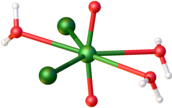Uranyl chloride
[O=U=O]Cl2
| |
| Names | |
|---|---|
| IUPAC name
Dichlorodioxouranium
| |
| Other names
Uranium(VI), dichlorodioxy
| |
| Identifiers | |
3D model (
JSmol ) |
|
| ChemSpider | |
ECHA InfoCard
|
100.029.315 |
| EC Number |
|
PubChem CID
|
|
| UNII | |
CompTox Dashboard (EPA)
|
|
| |
SMILES
| |
| Properties | |
| UO2Cl2 | |
| Molar mass | 340.90 |
| Melting point | Decomposes |
| Boiling point | Decomposes |
| Solubility in other solvents | 320 @ 18C |
| Hazards | |
| Safety data sheet (SDS) | External MSDS |
Except where otherwise noted, data are given for materials in their standard state (at 25 °C [77 °F], 100 kPa).
| |
Uranyl chloride refers to inorganic compounds with the formula UO2Cl2(H2O)n where n = 0, 1, or 3. These are yellow-colored salts.
Synthesis and structures

The hydrates are obtained by dissolving uranyl sulfate or uranyl acetate in hydrochloric acid followed by crystallization from concentrated solutions. Depending on the method of drying, one obtains the mono- or the trihydrate. The monohydrate is described as a yellow, sulfur-like powder. It is very hygroscopic.[2] The trihydrate is greenish-yellow. Both hydrates are fluorescent solids that are highly soluble in water.[3]
The anhydrous material can be obtained by the reaction of oxygen with uranium tetrachloride:
- UCl4 + O2 → UO2Cl2 + Cl2
In terms of structures, all three of these compounds feature the uranyl center (trans-UO22+) bound to five additional ligands, which can include (bridging) chloride, water, or another uranyl oxygen.[4][5]
Reactions
The
Industrial importance
The company
References
- .
- ISBN 978-0-470-13238-8.
- ^ F. Hein, S. Herzog (1963). "Uranyl Chloride". In G. Brauer (ed.). Handbook of Preparative Inorganic Chemistry, 2nd Ed. Vol. 2. NY, NY: Academic Press. p. 1439.
- .
- ISBN 978-0-470-13236-4.
- .
- "Uranium". Encyclopædia Britannica. Vol. V27. 1911. p. 788.
- Heyes, S.J. (1998). "Lanthanides & Actinides". Four Lectures in 2nd Year Inorganic Chemistry. Archived from the original on 23 September 2017. Retrieved 22 November 2011.
External links
- Settle, Frank. "Nuclear Chemistry and the Community". www.chemcases.com: General Chemistry Case Studies. Archived from the original on 22 November 2011. Retrieved 22 November 2011.
